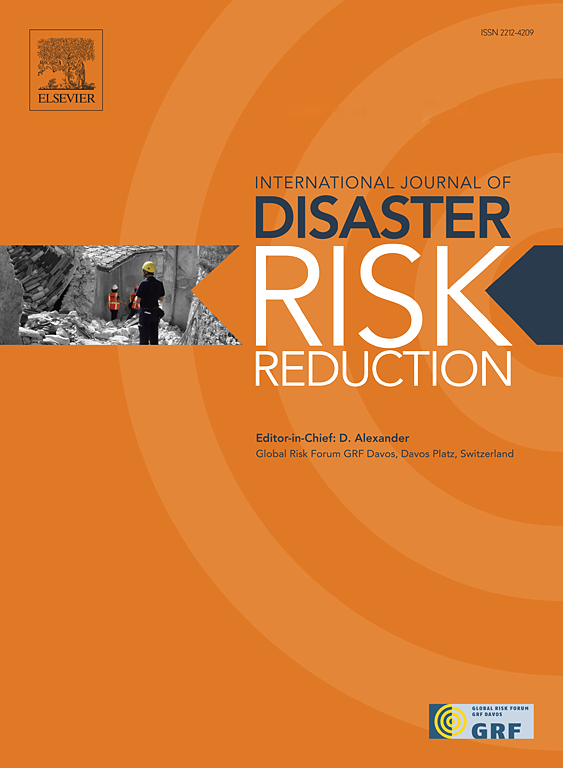风暴后的学习:飓风后长时间计划外学校关闭的特征和理解
IF 4.5
1区 地球科学
Q1 GEOSCIENCES, MULTIDISCIPLINARY
International journal of disaster risk reduction
Pub Date : 2025-05-27
DOI:10.1016/j.ijdrr.2025.105611
引用次数: 0
摘要
学校是教育和社会服务的重要枢纽。然而,灾害可能会迫使它们意外地长时间关闭,导致学习损失和恢复不稳定。在2011-12学年至2018-19学年期间,超过1340万美国学生经历了至少一周的学校关闭。尽管先前的研究强调了延长学校关闭时间如何挑战区域恢复工作,但影响飓风相关的延长关闭时间的因素仍然没有得到充分的大规模探索。在本研究中,我们使用统计学习模型来表征2011年至2019年美国大西洋盆地所有学区飓风后意外延长学校关闭的可能性和持续时间。我们发现,包括风速和降水在内的灾害强度指标是解释长时间关闭可能性和持续时间的重要因素之一。此外,区域资源也发挥着重要作用。较高的学生人均支出和全区人均收入使各区更有可能经历长时间的关闭,这表明地区在风险承受能力方面存在差异,或者表明资源匮乏的学校了解自己在促进复苏方面的独特作用,并迅速采取行动重新开放。然而,当关闭时间延长时,地区支出与关闭时间之间的关系更为复杂;在支出的第70百分位之前,增加人均学生支出与较短的关闭时间有关,在这一点上,增加支出与较长的关闭时间有关。最后,政治倾向很重要,倾向保守的地区关闭的时间更长。我们的研究结果为政策制定者、学校管理者和应急管理人员提供了具体的证据,说明了学校长期关闭的原因,并为建立社区应对未来飓风的韧性提供了证据。本文章由计算机程序翻译,如有差异,请以英文原文为准。
Learning after the storm: Characterizing and understanding prolonged unplanned school closures after hurricanes
Schools are critical hubs for both education and social services. However, disasters can force them to close unexpectedly and for prolonged periods, leading to learning loss and precarity in recovery. Between the 2011-12 and 2018-19 school years, over 13.4 million U.S. students experienced school closures lasting at least one week. Despite prior research highlighting how extended school closures can challenge regional recovery efforts, the factors that influence the duration of hurricane-related prolonged closures remain insufficiently explored at scale. In this study, we use statistical learning models to characterize both the likelihood and duration of unplanned prolonged school closures following hurricanes across all school districts in the Atlantic basin of the United States from 2011 to 2019. We find that indicators of hazard intensity, including wind speed and precipitation are among the important factors in explaining both the likelihood and duration of prolonged closures. Additionally, regional resources play a significant role. Higher per capita spending on students and district-wide per capita income makes districts more likely to experience prolonged closures, suggesting regional differences in risk tolerances or that low-resource schools understand their unique role in facilitating recovery and act quickly to reopen. However, the relationship between district expenditures and closure duration is more complex when prolonged closures occur; increasing per capita student spending is associated with shorter closures up until the 70th percentile of expenditures, at which point, increasing expenditures is associated with moderately longer closures. Finally, political leaning is important, with more conservative-leaning districts experiencing longer-duration closures. Our findings offer concrete evidence for policymakers, school administrators, and emergency managers on contributors of prolonged school closures and for building community resilience in the face of future hurricanes.
求助全文
通过发布文献求助,成功后即可免费获取论文全文。
去求助
来源期刊

International journal of disaster risk reduction
GEOSCIENCES, MULTIDISCIPLINARYMETEOROLOGY-METEOROLOGY & ATMOSPHERIC SCIENCES
CiteScore
8.70
自引率
18.00%
发文量
688
审稿时长
79 days
期刊介绍:
The International Journal of Disaster Risk Reduction (IJDRR) is the journal for researchers, policymakers and practitioners across diverse disciplines: earth sciences and their implications; environmental sciences; engineering; urban studies; geography; and the social sciences. IJDRR publishes fundamental and applied research, critical reviews, policy papers and case studies with a particular focus on multi-disciplinary research that aims to reduce the impact of natural, technological, social and intentional disasters. IJDRR stimulates exchange of ideas and knowledge transfer on disaster research, mitigation, adaptation, prevention and risk reduction at all geographical scales: local, national and international.
Key topics:-
-multifaceted disaster and cascading disasters
-the development of disaster risk reduction strategies and techniques
-discussion and development of effective warning and educational systems for risk management at all levels
-disasters associated with climate change
-vulnerability analysis and vulnerability trends
-emerging risks
-resilience against disasters.
The journal particularly encourages papers that approach risk from a multi-disciplinary perspective.
 求助内容:
求助内容: 应助结果提醒方式:
应助结果提醒方式:


